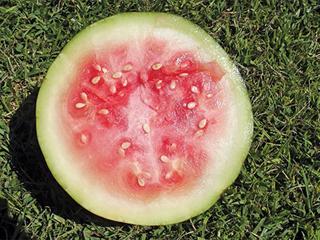
Today’s buyers are very discerning. ‘Eating quality’ is influenced by the stage of harvest and the health of the plant at harvest. Any pest or disease that affects the functioning of the leaves before harvest will affect the sweetness of the fruit.
Be careful here.
There may be no visible difference between a melon that becomes diseased shortly before harvest and one that remains healthy. Watermelons are usually auctioned in batches at the market and buyers check the internal quality before bidding. These are professionals who know their job; don’t take a chance by neglecting disease control immediately prior to harvest.
Make sure it shapes up
The shape is also important and must conform to the specifications of the variety. Incorrect fertilisation can result in lumpy fruit, which is off-putting to buyers. Misshapen fruit can also be due to poor flower fertilisation, resulting in too few seeds developing. This can be caused by insufficient pollinators or poor weather conditions, reducing bee activity.
Misshapen fruit will be noticed at an early stage. It’s worthwhile getting your workers to go down the rows and remove deformed fruit. This will not be a loss, as the watermelon plant produces more female flowers than fruit, and determines how many fruit to form according to leaf growth and other conditions, such as fertility and climate.
When a fruit is removed at an early atage, the plant perceives that it has the capacity to produce more fruit and will do so. In addition, the cost of labour required to remove the deformed fruit will be more than compensated for by a higher return per hectare.
Determining ripeness
Naturally, you will want to get the melons to market as soon as possible – especially early in the season – and so get the highest possible price. But it’s important to make certain that the fruit is at the correct stage of ripeness at harvest before you try to sell them. Consumers get angry after having bought a watermelon, only to find that it’s unripe. These melons are often returned to the outlets – and the problem gives the industry a bad name.
Some experience is required to determine ripeness. One useful indicator is to check the little cup-shaped leaf on the vine nearest the fruit – this tends to dry out when the melon is ripe. An experienced harvester can tell ripeness by tapping the fruit and listening to the tone – just as wheel tappers do on the railway carriages, where a dull tone indicates a crack in the wheel. In the same way, ripe fruit will have a slightly duller tone compared with the ‘sharper’ sound of an immature fruit. Fruit that’s too mature will have an even duller tone when tapped.
You can compensate slightly by harvesting a little before full ripeness if the fruit is to travel a long distance. But it will still need to be sufficiently ripe for good eating. It is preferable to use clippers when harvesting rather than twisting or pulling the fruit. It’s also much quicker.
Pack the fruit in demarcated rows to simplify loading onto the trailer or lorry. And take care to prevent cracking or bruising. Place the fruit flat on the ground, not on its end, in the demarcated row. Also, avoid throwing the fruit onto the lorry or trailer or packing too much – this can cause bruising, especially if the vehicle has to travel along a bumpy road. Pack straw in layers to help protect the fruit on the way to the market.












